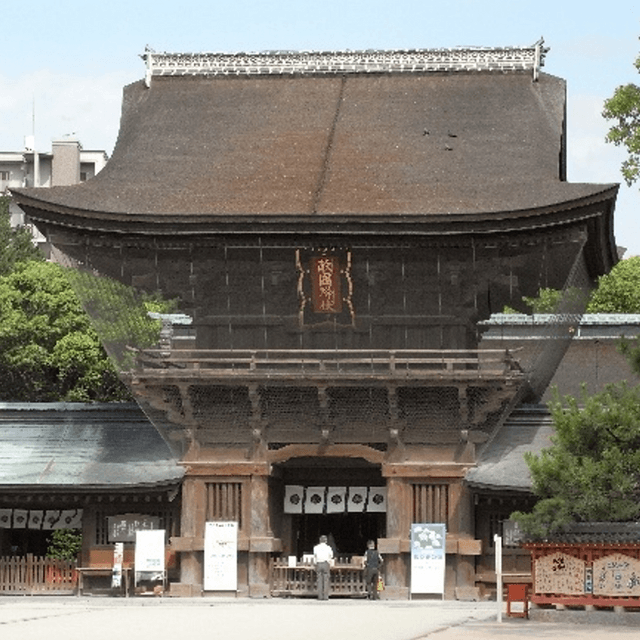
延長元(923)年、穂波郡(ほなみぐん)大分八幡宮(だいぶはちまんぐう)から移設されたのが創建とされています。神功皇后(じんぐうこうごう)が応神天皇(おうじんてんのう)を生んだ際に、胞衣(えな)を筥に入れてこの地に埋め、目印として松の木を植えたことから、この松を「筥松」、この地を「筥崎」と呼ぶようになったと伝えられています。石清水(京都府)・宇佐(大分県)とともに三大八幡といわれ、広く崇敬を集める一方、1月に行われる玉取祭(玉せせり、市指定美敬無形民俗文化財)、9月の放生会(ほうじょうや)はそれぞれ福岡の風物詩として市民に親しまれています。2年に1度(奇数年)に放生会にあわせて行われる神幸行事は市指定無形民俗文化財になっています。
本殿、拝殿、楼門、一ノ鳥居、石燈籠が国の有形文化財に指定されている他、境内の禁断碑、蒙古碇石(もうこいかりいし)、木造亀山上皇立像(もくぞうかめやまじょうこうりつぞう)、また、箱崎八幡宮縁起、刀・太刀、銅製鉢・酒瓶などの収蔵品が県の有形文化財に指定されています。
本殿、拝殿は天文(てんぶん)15(1546)年に大宰大弐(だざいのだいに)大内義隆(おおうちよしたか)により建立したものです。本殿は九間社流造(きゅうけんしゃながれづくり)の様式で、柱は朱漆塗、屋根は檜皮葺(ひわだぶき)、左右には車寄せをもっています。
「伏敵門(ふくてきもん)」とも呼ばれる楼門は、名島城主小早川隆景(こばやかわたかかげ)が文禄(ぶんろく)3(1594)年に建立したもので、広大な屋蓋(おくがい)や扉の桐花紋の彫刻に、室町末期の様式を残しています。楼上に揚げられた「敵国降伏」の額は宸翰(しんかん)(天皇の直筆の文書)のうち1葉を模写拡大したもので、文永(ぶんえい)の役(1274)後、社殿再建に尽くした亀山上皇が納めたものと伝えられています。現在の額は平成15年に復原作成されたものです。
It is said that the shrine was founded in Enchō 1 (923) when the deity was transferred here from Daibu Hachiman Shrine in Honami District. According to legend, when Empress Jingū gave birth to Emperor Ōjin she placed the placenta in a box and buried it at this site, then planted a pine as a marker; from this the pine came to be called the “Hakomatsu,” and the place “Hakozaki.” Counted together with Iwashimizu (Kyoto Prefecture) and Usa (Ōita Prefecture) as one of the Three Great Hachiman Shrines, it enjoys widespread veneration. At the same time, the Tamatori Festival (Tamaseseri)—held in January and designated by the city as an intangible folk cultural property—and the Hojoya held in September are beloved by residents as seasonal icons of Fukuoka. The divine procession conducted every two years (in odd-numbered years) to coincide with the major Hojo-ya festival is also designated by the city as an Intangible Folk Cultural Property.
In addition to the main sanctuary, worship hall, rōmon (tower gate), first torii, and stone lanterns—each designated as Registered Tangible Cultural Properties of Japan—the precincts also contain the Prohibition Stele, Mongol anchor stones, and a wooden standing statue of the Emperor Emeritus Kameyama; moreover, holdings such as the “Origin Legend of Hakozaki Hachiman Shrine,” swords and long swords, and bronze bowls and sake bottles are designated as Tangible Cultural Properties of Fukuoka Prefecture.
The main sanctuary and worship hall were built in Tenbun 15 (1546) by Ōuchi Yoshitaka, then Dazai Daini (Senior Assistant Governor-General of the Dazaifu government). The main sanctuary is in the nine-bay nagare-zukuri style, with vermilion-lacquered pillars and a cypress-bark roof, and has carriage porches to left and right.
The rōmon—also known as the “Futekimon” (“Subduing Foes Gate”)—was erected in Bunroku 3 (1594) by Kobayakawa Takakage, lord of Najima Castle. Its expansive roof canopy and the paulownia crests carved on the doors preserve the style of the late Muromachi period. The plaque hung above, bearing the phrase “Tekikoku Kōfuku” (“May the enemy nation submit [in defeat]”), is an enlarged copy of an imperial autograph; tradition holds that it was presented by the Retired Emperor Kameyama in gratitude after the Bun’ei War (1274) during the shrine’s reconstruction. The present plaque is a faithful reproduction created in 2003 (Heisei 15).
スタンプを獲得すると、限定の壁紙をゲットできます。
スタンプを集めてね / Collect a stamp
限定の壁紙を獲得しました。
以下のボタンから壁紙を表示し、長押しで”写真”に保存してください。
